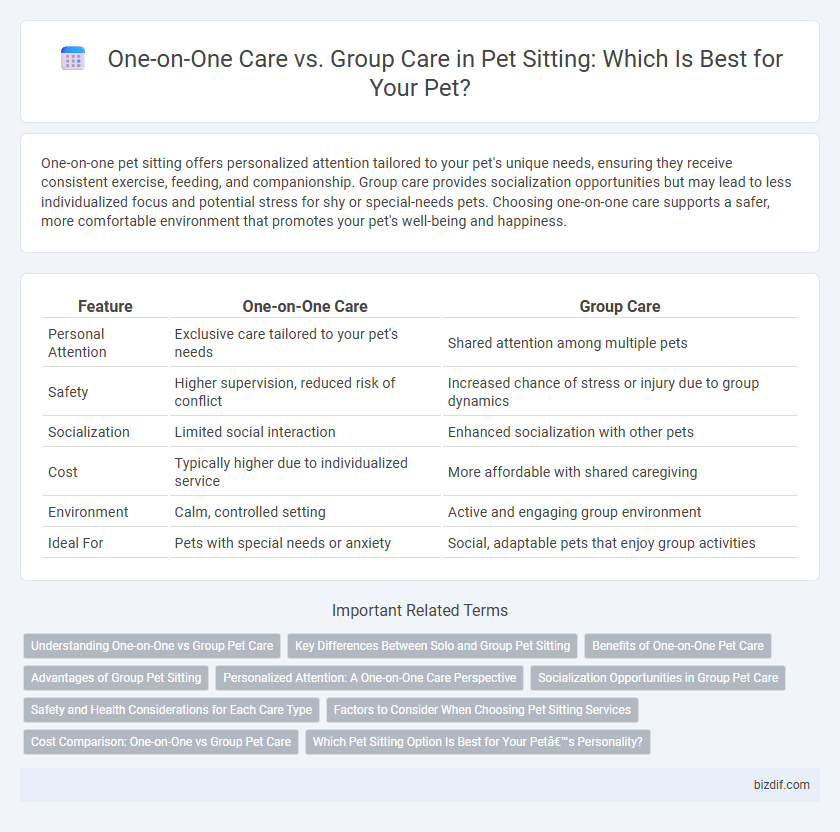One-on-one pet sitting offers personalized attention tailored to your pet's unique needs, ensuring they receive consistent exercise, feeding, and companionship. Group care provides socialization opportunities but may lead to less individualized focus and potential stress for shy or special-needs pets. Choosing one-on-one care supports a safer, more comfortable environment that promotes your pet's well-being and happiness.
Table of Comparison
| Feature | One-on-One Care | Group Care |
|---|---|---|
| Personal Attention | Exclusive care tailored to your pet's needs | Shared attention among multiple pets |
| Safety | Higher supervision, reduced risk of conflict | Increased chance of stress or injury due to group dynamics |
| Socialization | Limited social interaction | Enhanced socialization with other pets |
| Cost | Typically higher due to individualized service | More affordable with shared caregiving |
| Environment | Calm, controlled setting | Active and engaging group environment |
| Ideal For | Pets with special needs or anxiety | Social, adaptable pets that enjoy group activities |
Understanding One-on-One vs Group Pet Care
One-on-one pet sitting offers personalized attention tailored to a pet's unique needs, ensuring individualized feeding, exercise, and companionship. Group care, while providing socialization and playtime with other animals, may involve less focused supervision and can be overwhelming for some pets. Choosing between these options depends on a pet's temperament, medical requirements, and socialization skills to optimize their well-being.
Key Differences Between Solo and Group Pet Sitting
One-on-one pet sitting offers personalized attention tailored to the individual pet's needs, ensuring customized feeding, exercise, and companionship routines. Group pet sitting involves multiple pets simultaneously, which can promote socialization but may limit the sitter's ability to provide focused care for each animal. Choosing between solo and group pet sitting depends on the pet's temperament, activity level, and specific requirements for interaction and supervision.
Benefits of One-on-One Pet Care
One-on-one pet sitting delivers personalized attention tailored to your pet's unique needs, reducing anxiety and promoting emotional well-being. Individual care ensures consistent monitoring of health, behavior, and dietary requirements, preventing conflicts and stress often seen in group settings. This dedicated approach enhances the bond between sitter and pet, resulting in a more comfortable and secure environment for your furry companion.
Advantages of Group Pet Sitting
Group pet sitting offers socialization opportunities that enhance pets' mental stimulation and reduce anxiety. It provides cost-effective care by sharing sitter attention among multiple pets, making it budget-friendly for owners. Group settings also promote natural play behaviors, improving pets' physical health and overall well-being.
Personalized Attention: A One-on-One Care Perspective
One-on-one pet sitting ensures personalized attention crucial for addressing individual pets' needs, behaviors, and medical requirements, which group care often cannot provide due to divided focus. This tailored approach enhances the pet's comfort, reduces anxiety, and allows for customized feeding, exercise, and medication schedules. Personalized care in one-on-one settings fosters stronger bonds between the sitter and pet, leading to improved emotional well-being and overall health.
Socialization Opportunities in Group Pet Care
Group pet care enhances socialization opportunities by allowing pets to interact with multiple animals, promoting improved behavior and reduced anxiety through peer engagement. One-on-one care offers personalized attention but lacks the dynamic social experiences found in group settings that help develop communication skills and energy regulation. Structured group interactions stimulate natural instincts and provide essential mental and physical exercise, crucial for a balanced pet lifestyle.
Safety and Health Considerations for Each Care Type
One-on-one pet sitting ensures personalized supervision, reducing the risk of injuries and stress-related behaviors by catering to the individual pet's health needs and temperament. Group care can increase social interaction but poses higher risks of disease transmission and potential conflicts among pets, requiring strict health screenings and constant monitoring. Prioritizing safety in each care type involves tailored protocols, such as individualized feeding schedules and quarantine measures, to maintain optimal health and well-being.
Factors to Consider When Choosing Pet Sitting Services
One-on-one pet sitting offers personalized attention tailored to your pet's specific needs, making it ideal for pets with special health requirements or anxiety issues. Group care can provide socialization opportunities and cost-effectiveness but may lack individualized monitoring, which is critical for pets needing constant supervision. Consider factors like your pet's temperament, health conditions, and the sitter's ability to manage multiple animals before choosing between one-on-one and group pet sitting services.
Cost Comparison: One-on-One vs Group Pet Care
One-on-one pet care typically costs more than group care due to personalized attention and customized services tailored to a pet's unique needs. Group pet care offers a more affordable option by sharing resources and caregiver time among multiple pets, though it may lack individualized monitoring. Evaluating the price difference alongside the pet's temperament and health requirements helps determine the most cost-effective and suitable care option.
Which Pet Sitting Option Is Best for Your Pet’s Personality?
One-on-one pet sitting provides personalized attention tailored to your pet's specific needs, making it ideal for shy, elderly, or high-maintenance animals requiring focused care. Group care offers social interaction and play opportunities, benefiting extroverted or energetic pets that thrive in a stimulating environment with other animals. Assessing your pet's temperament, anxiety levels, and activity preferences helps determine the most suitable pet sitting option for optimal comfort and well-being.
One-on-one care vs Group care Infographic

 bizdif.com
bizdif.com